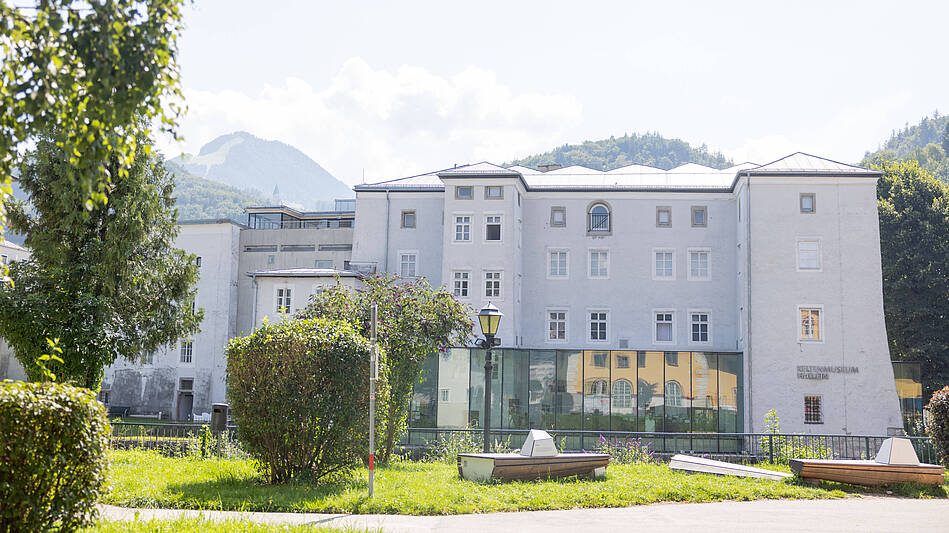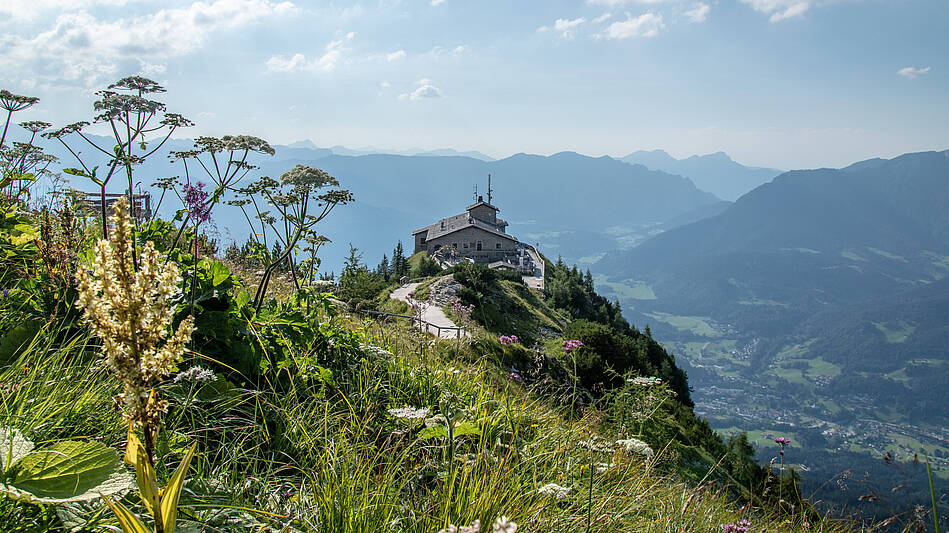History of Salzburg

A brief history of Salzburg
Salzburg, known for its baroque architecture, the Hohensalzburg Fortress and as the birthplace of Wolfgang Amadeus Mozart, looks back on a rich and multifaceted history. From early times through the Middle Ages to modern times, Salzburg has developed into one of the most important cities in Austria. This historical journey begins in the Stone Age and takes us through the centuries to the present day.
With our Blue HOP ON HOP OFF line, you also have the opportunity to plan your very own historical journey through Salzburg! Start from Mirabellplatz and travel to Hallein, where one of the most unspoiled old town centers in Austria awaits you, as well as the Hallein Celtic Museum, one of the largest museums of Celtic history and art in Europe. Afterwards, cross the border to Germany with us and get off at station no. 19 "Dokumentation Obersalzberg/Kehlsteinhaus" and visit the famous Eagle's Nest and look out over the breathtaking Berchtesgaden mountains.
Early history and antiquity
Salzburg in the Stone Age
In the Neolithic period, the region that is now Salzburg was already inhabited by people, as numerous archaeological finds prove. Particularly significant are the discoveries of stone tools and traces of settlements in the areas around the Untersberg and Dürrnberg near Hallein. These finds, including the remains of fireplaces and worked stones, indicate that early settlers were already using the region's natural resources around 4,000 years ago. The Dürrnberg is particularly well known for its later Celtic settlement remains, but there are also significant finds from the Stone Age that indicate early use of the salt deposits. These early settlements laid the foundations for the long and rich settlement history of the Salzburg region. Archaeological discoveries prove that people began to mine and trade the salt as early as the Neolithic period.
Celts in Salzburg
Before the Romans conquered the region, Salzburg was a center of Celtic culture. The Celts, who lived in the region from the 5th century BC, left behind significant traces. The Celtic settlement on today's Mönchsberg is considered the forerunner of the city of Salzburg. The Celts, especially the Noric tribe, mined salt intensively and traded this "white gold" far beyond the borders of their empire. The Celts began mining salt on the Dürrnberg around 750 BC. Their culture and trade laid the foundations for Salzburg's later importance. You can find out more about the history of the Celts at the Hallein Celtic Museum, which is one of the largest museums of Celtic history and art in Europe - just get off at stop no. 15!
Romans in Salzburg
In 15 BC, the area was conquered by the Romans, who incorporated the Celtic settlement into their province of Noricum. They founded the city of "Iuvavum" here, which became an important commercial and administrative center. The Romans built roads, bridges and public buildings that shaped the cityscape. Under Roman rule, the region experienced an economic boom and salt continued to play a central role. Iuvavum developed into one of the most important places in the province before the city slowly lost its importance after the fall of the Roman Empire.
Middle Ages
Archdiocese of Salzburg
The next important phase in Salzburg's history began in the 7th century with Christianization. St. Rupert, who is considered the founder of the city, established the monastery of St. Peter and Nonnberg Abbey here in 696. He made Salzburg the religious center of the region. Under subsequent archbishops, Salzburg developed into a powerful principality that combined both spiritual and secular power. In the Middle Ages, Salzburg was an important center of art and culture, and the archbishops promoted the construction of churches, monasteries and fortifications. The city grew and flourished, not least due to the salt trade, which made the city rich and influential. In the 11th century, work finally began on the construction of Hohensalzburg Fortress, which is one of the most important landmarks of the city of Mozart. The reason for the construction of the fortress was the investiture dispute between Pope Gregory VII and the German Emperor Henry IV, the Pope was ultimately also supported by the Archbishopric of Salzburg.
Modern times
The transition to modern times marked a phase of cultural and architectural upswing for Salzburg. During the Renaissance, the city experienced its first heyday, in which humanism and art shaped life. However, this development reached its peak in the Baroque period, when Salzburg became one of the most magnificent cities in the Holy Roman Empire under Archbishops Wolf Dietrich von Raitenau, Markus Sittikus and Paris Lodron. During this period, important buildings such as Hellbrunn Palace with its famous trick fountains and Mirabell Gardens, which with its symmetrical design and ornate statues remains an outstanding example of Baroque garden art to this day, were built. These buildings are an expression of the power and cultural aspirations of the archbishops and still characterize the image of the city.
Salt
Salt City Salzburg
The "white gold" - salt - has been the basis of Salzburg's wealth for centuries. The discovery of salt dates back to the Neolithic Age, when people discovered that salt could be used to preserve meat. Salt became increasingly important as a preservative due to the deterioration of the climate towards the end of the Bronze Age, so salt mining began on the Dürrnberg in the 6th century BC. The salt deposits formed the basis of the settlers' livelihood and ensured work and prosperity. However, this changed with the arrival of the Romans, who brought salt mining to a standstill. In 1191, the Salzburg prince archbishops finally rediscovered salt production as a source of wealth. The salt trade made the archbishops powerful rulers and the city an important trading center in Central Europe. Salt production and trade were strictly controlled and organized, which secured the Principality of Salzburg a monopoly position in the region. The income from the salt trade enabled the archbishops to transform the city into a magnificent Baroque metropolis, which still characterizes the cityscape today.
Modernity
Salzburg in the 18th and 19th centuries
Salzburg experienced a cultural high point in the 18th century, particularly under Archbishop Hieronymus von Colloredo, who supported Wolfgang Amadeus Mozart. However, with secularization at the beginning of the 19th century, Salzburg lost its status as a prince-bishopric and became part of the Habsburg Empire. This political change led to a change in the city's development. During the Napoleonic Wars, Salzburg changed hands several times before it was finally awarded to Austria in 1816. The city lost its economic importance, but remained a cultural center.
20th century
In the 20th century, Salzburg, like many other European cities, was shaped by the events of the two world wars. During the Second World War, the old town was largely spared destruction, but the population suffered from the bombing raids and the occupation. After the war, Salzburg quickly developed into an important center of international tourism and culture. The founding of the Salzburg Festival in 1920 made a significant contribution to establishing Salzburg as a world city of music.
Another place that has a significant connection with the Second World War is the Eagle's Nest, which is still a reminder of the abysses of the inhuman Nazi dictatorship. The Eagle's Nest has been run as a mountain restaurant since 1952. At the same time, the Obersalzberg Documentation serves as a place of learning and remembrance and deals with the history of the Obersalzberg and the Nazi dictatorship. Both places can be easily visited by taking the Blue Line and getting off at station no. 19. (Please note that the shuttle bus from the Obersalzberg stop to the Eagle's Nest must be booked separately).
Tourism and heritage
Today, Salzburg is one of the most visited cities in Austria. The historic old town was declared a UNESCO World Heritage Site in 1997, ensuring the preservation of its baroque architecture and cultural heritage. Millions of tourists visit the city every year to see the historic buildings, the impressive churches, the Hohensalzburg Fortress and the locations of the movie "The Sound of Music". Salzburg is not only a city with a rich history, but also a vibrant center of art and culture that combines the past and modernity in a unique way.
Conclusion
Salzburg's history is a story of change and continuity. From the early settlements to the heyday as an archbishopric to the modern cultural metropolis - the city has reinvented itself time and time again while retaining its unique identity. The traces of the past are still visible everywhere today, making Salzburg a living history book that takes visitors back in time.


